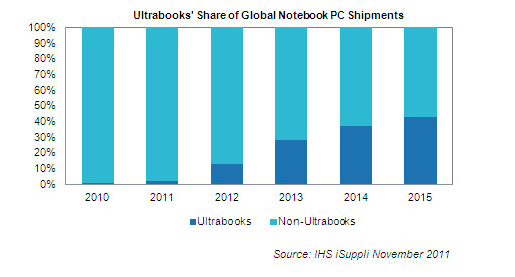Ultrabooks: Four things that will make or break the category

A week from now you may never want to hear the word "ultrabook" again. The Consumer Electronics Show will bring non-stop ultrabook chatter to the fore. And if that's not enough CeBit is likely to be ultrabook heavy too.
You know the ultrabook story by now. Intel has hatched a plan to reinvent the PC with thin, responsive, power sipping laptops. Think the MacBook Air for the Windows crowd. The reviews have been solid and ultrabooks have a lot going for them---notably a thickness of 0.8 inches and some features found in tablets.

Intel is making a big push with ultrabooks and working with multiple supply chain partners and Intel Capital to lower platform costs from the current ~$1000+ ASPs to a more palatable ~$800 – with CES-Computex-CeBit as launch venues. We should note prior endeavors such as the CULV and netbook platforms have been successful and so we would not be betting against it. Nonetheless, we believe the 40% ultrabook penetration for C2012 might be too high.
Also see: CNET's CES 2012 coverage
In other words, a lot of folks are clinging to this stat that 40 percent of notebooks will be ultrabooks. What will it take to get there? Here are five items that need to line up for ultrabooks to be a crazy success.
Price. Intel has 60 design wins for next-gen ultrabooks in the queue. That's a good thing given that competition will be needed to lower ultrabook prices. CNET's Brooke Crothers said:
Price may be the single most important metric for ultrabooks. Toshiba has been leading the way this year, going as low as $699 on its Portege Z835. Expect more of this in 2012. HP, for example, doesn't shy away from price competition. Its Folio 13 offers a lot for $899, including a Core i5 processor, a 128GB solid-state drive, USB 3.0, and great battery life.
Is $699 the magic price? Probably not. Perhaps $500 is the benchmark. Tablets and laptops are increasingly looking like competitors not complements. The sooner prices fall, the faster consumers will gobble up ultrabooks.
The MacBook. No matter how much you love ultrabooks, Apple created the category. Price will matter for ultrabook success largely due to Apple prices. At $800, many folks will go MacBook Air over the ultrabook assuming they can handle an 11-inch screen (I can't) starting at $999. At $1,299 for a 13-inch MacBook Air, an ultrabook at half that price is very appealing. The challenge for ultrabooks is that the PC industry is going where Apple has been---not where it's going. Apple could cut prices, cook up new designs and offer more screen variety to fend off ultrabooks.